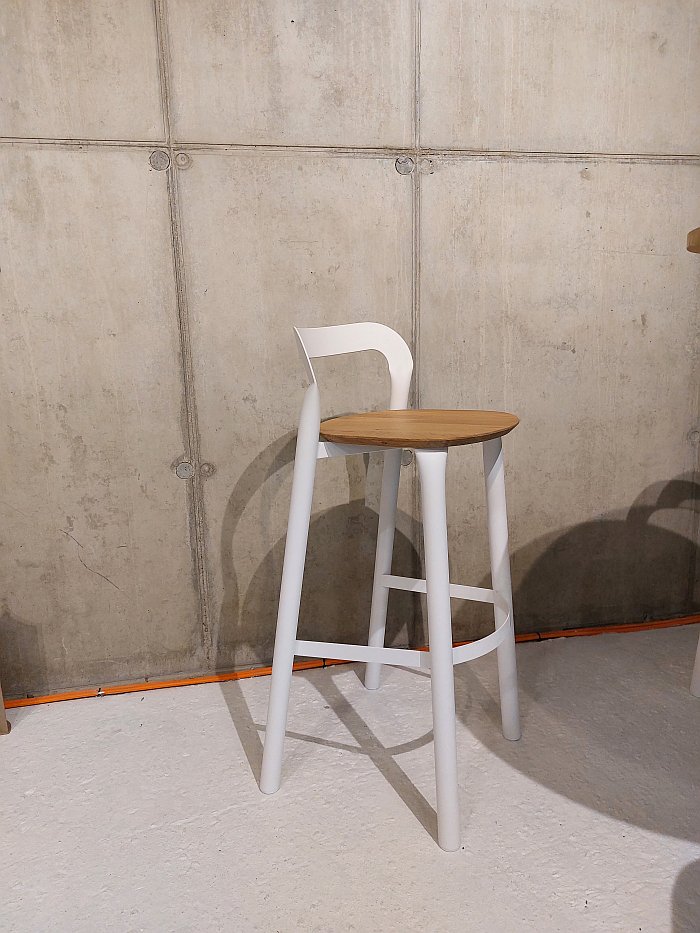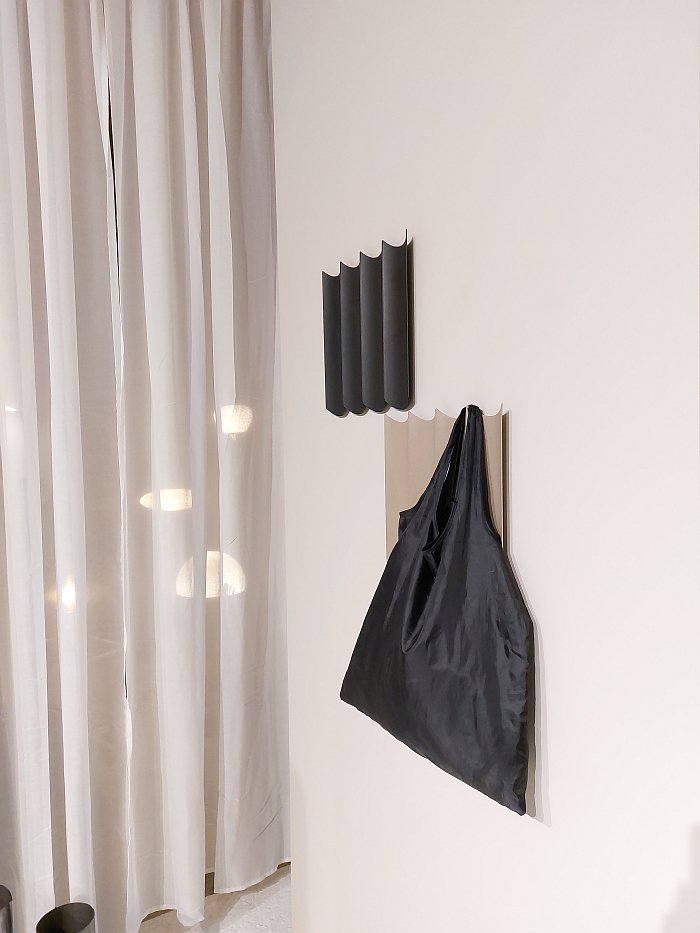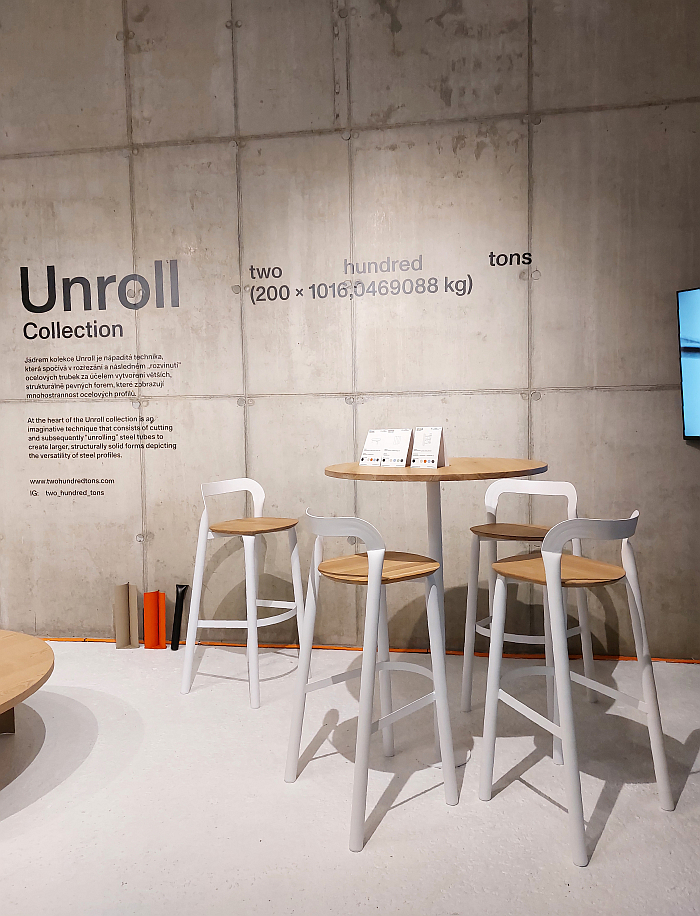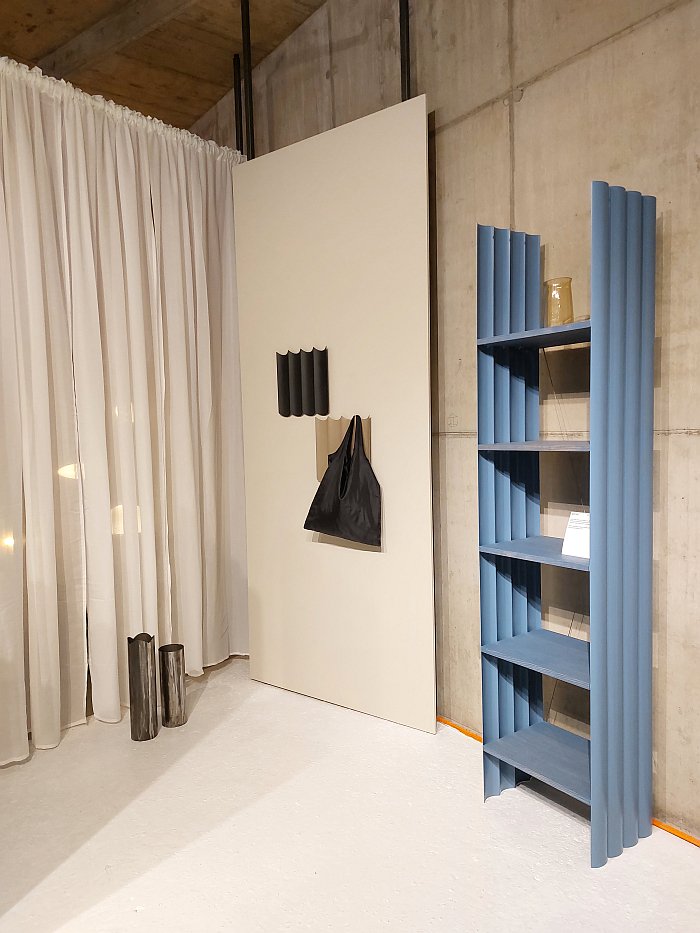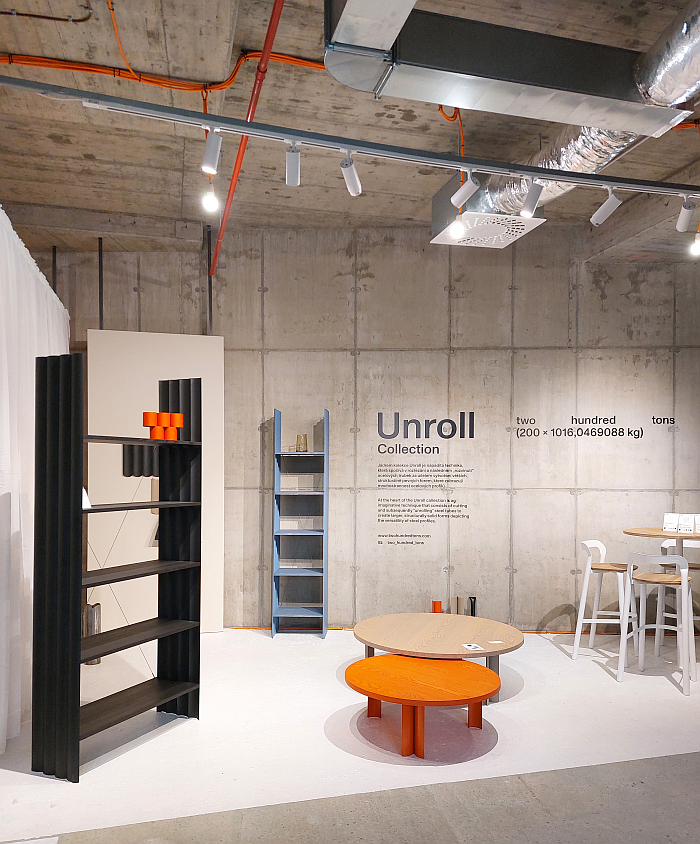
It's more or less a century since the first steel tube furniture was developed, and looking around you it's relatively easy to believe that since then everything has been done, that steel tube furniture has reached its full potential.
Or perhaps more accurately; because the contemporary popular understanding of steel tube furniture is the steel tube furniture from the earliest days of steel tube furniture, and because the steel tube furniture from the earliest days of steel tube furniture defines not only steel tube furniture but popular understandings of the furniture of the first third of the 20th century, a period popularly (if incorrectly) perceived as being entirely furnished with steel tubing, it's relatively easy to believe that since then everything has been done, that steel tube furniture has reached its full potential.
Au contraire, mon ami!
There are still individuals out there patiently exploring the possibilities of steel tubing, quietly resisting the easy clichés that can be found in the myriad (commercially motivated) coffee table photo books and unreflective social media accounts that so skew both the (hi)story of furniture design and the contemporary realities.
Individuals such as Daniel Lorch (and Tecta) who, with the aid of nothing more than a little magic dust, and ye olde witchcraft, split a steel tube almost along its full length and then twisted the two halves to form a whole chair.
Or individuals such as Prague based duo Monika Kozderková and Adam Štok who sought assistance not from magic dust, nor from witchcraft, but from the Two Hundred Tons of their company's name.
Two hundred tons per square metre to be precise.
Two hundred tons of pressure that when judiciously and targetedly applied to a bent steel tube creates the rear legs and backrest for a bar stool and/or dining chair. Which is not just a neat trick, but a very satisfying trick. A trick that elucidates how little we understand tubular steel as a material for furniture construction, how much there is still to learn after a century or so of acquaintance. That the 1920s were but the beginning of steel tube furniture, not the end they are popularly conceived as being.
And a trick that reinforces the importance of the production process in the design process; reinforces the production process as being every bit as relevant as the choice of material in the design process; reinforces the production process as an active component of design rather than a passive means to realising a design. Reinforces the production process as something any and every designer needs must consider from the very start of any end every project. And ideally consider it as judiciously and targetedly as Monika and Adam did. Or as Thomas Schnur did. Viewing Two Hundred Tons' Nyiny bar stool and Nyiny dining chair we were reminded of Thomas's Twist Table whose frame is stabilised by nothing more advanced than, well, twisting a flat piece of sheet steel to imbue it with the necessary stability. Much as the stability of Michael Thonet's Chair 14 arises from a 3D twist to a length of warm beech tubing. A twist that also forms the backrest. The parallels between Michael Thonet and Two Hundred Tons are many, and delicious. Or the Bouroullec's Officina collection with its bent iron rods. Two Hundred Tons press. One studio's twisting is an other studio's bending is another studio's pressing. Simple physical processes that produce visually simple objects, objects whose visual simplicity both belies their complexity, the complexity of their genesis, and also means that they can be readily adopted in any context, and that not least, we'll argue, because of the inherent honesty with which they communicate; they're not hiding anything, they want you to know their innermost secrets, don't want you to relate to them purely visually. That would upset them.
And simple physical processes, be that twisting, bending or pressing, that also produce objects with an inherent resource efficiency. And after neigh on a century of chasing time efficiency and personal efficiency, a century that has seen us move from Taylorist idealism to App-ist idealism without us ever approaching realism, is it not time we all focussed a little more on resource efficiency? Not just the recycling that is the focus of so many today, but primarily the avoiding of the need to recycle: resource efficiency in terms of durability, of longevity, of the eternity of which the Nyiny bar stool and dining chair speak so convincingly and warmly.
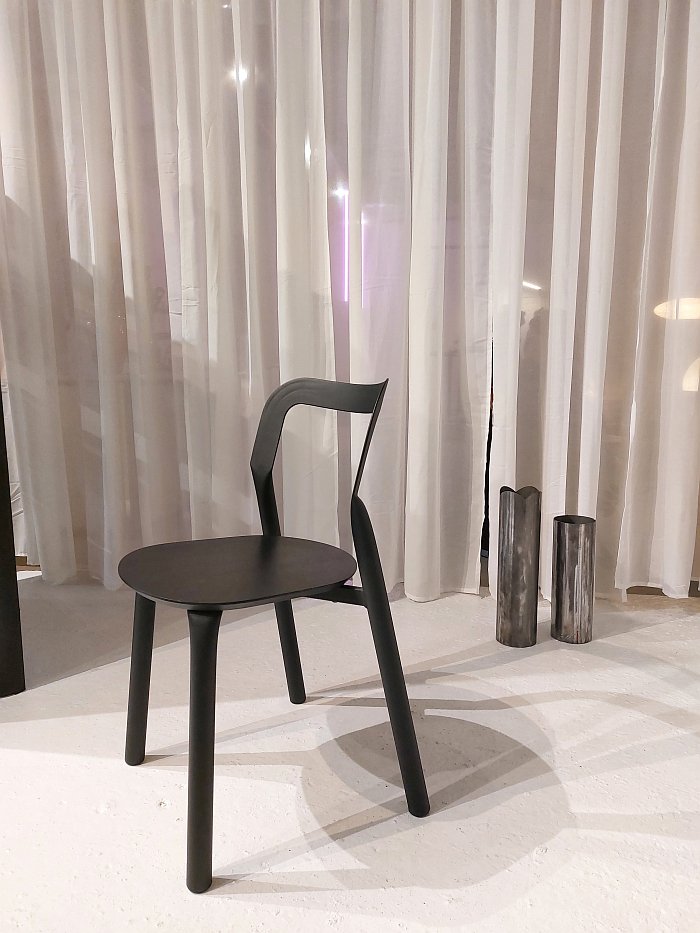
But, yes, you're right, for all our fascination with the rear legs and backrest, whereby we're technically obsessed with them, not merely fascinated... rear legs and backrest are a long way from being the functional pieces of furniture the Nyiny bar stool and dining chair are.
And while Monika and Adam could have repeated the pressed bent steel tube trick for the front legs, pleasingly they resisted that easy temptation and instead pinched a steel tube, so pressed and cut a steel tube, by way of creating a joint to the stretchers which combine rear and front legs, and atop of which they placed an oak seat.
A composition that, whether in the Nyiny bar stool or the Nyiny dining chair, results not only in a visually very coherent object with a goodly degree of self-confidence, not arrogance, self-confidence, a chunky, tactile, playful self-confidence, but a composition which also, and most importantly in seating furniture, offers a good seating comfort, not least through the support offered by the intelligently formed backrest. And also offer a little more: the bar stool additionally offering a very satisfying perch-on-the-edge-of-the-seat position should you wish to, to as it were, "sit half-standing" as Journal der Moden would no doubt phrase it; while the the depth to which the flattened section of the dining chair backrest reaches, means that as you lean back you can rest your upper arms on the flattened sections as if they were (near) vertical armrests, the construction principle, the production process, allows the chair to absorb you rather than simply accommodating you, which is very pleasing. Surprisingly so. And an experience you've probably never enjoyed because pressed steel tube dining chairs weren't previously a thing. Nor were (near) vertical armrests.
And Nyiny bar stools and dining chairs that also offer very good seating stability, which is another way of saying that for all their visual lightness they are physically heavy. Very. The dining chair is stackable but you don't want to carry half-a-dozen up a flight of stairs. Which is in no way a complaint rather a compliment, a confirmation of the quality.
Their material quality as an echo of their many, many other tangible and intangible qualities.
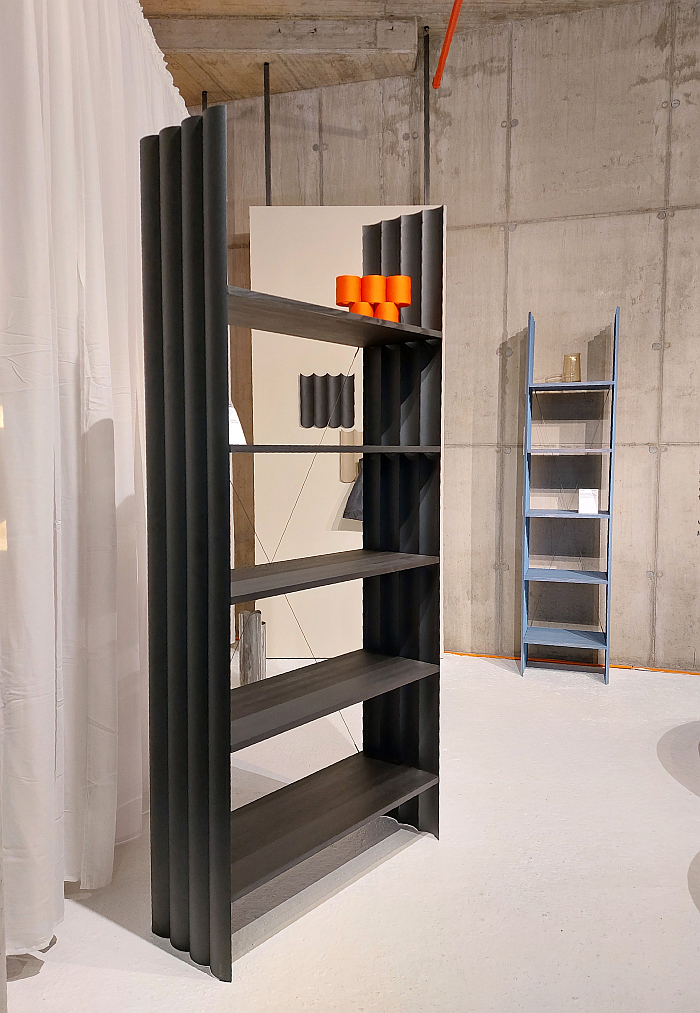
In addition to the, if one so will signature, eponymous, collection Two Hundred Tons also used the opportunity presented by Designblok 2024 to present their latest collection: Unroll.
A collection which, much as Daniel Lorch started by splitting a steel tube lengthways, starts by splitting a steel tube lengthways; albeit, in contrast to Daniel, splitting it all the way, and then, as the name of the collection neatly implies, unrolling the thus cut steel tube and using the unrolled steel tubes to create objects that whole steel tubing simply wouldn't be able to achieve, certainly not with the grace and elegance with which the unrolled steel tubing achieves them; objects which, if one so will, explain to steel tubing that while it is without question useful and meaningful in its familiar rolled form, it is equally as useful and meaningful in its unfamiliar unrolled form; is equally as useful and meaningful in a form that denies a tube its original function, but empowers it to take on new functions. Which may or may not be a metaphor. We're unsure. But might well be.
And a usefulness and meaningfulness that the popular fascination with rolled steel tubing means has tended to be ignored this past century or so; Two Hundred Tons tending to argue that may have been a (further) mistake of the human species this past century or so.
An argument formulated at Designblok 2024 as hook racks that are as effortlessly decorative as they are functional, by table legs that extend the composition via a very pleasing graphic quality, while themselves almost vanishing, and by shelving units whose non-functional curving undulations neatly disrupt the quadratic of not only the units but the space, bring a natural organic, an ease, to the object and the space that is calming, inviting, warming, thus proving themselves to be very functional curving undulations, just not in the technical sense 'function' is so often understood as being.
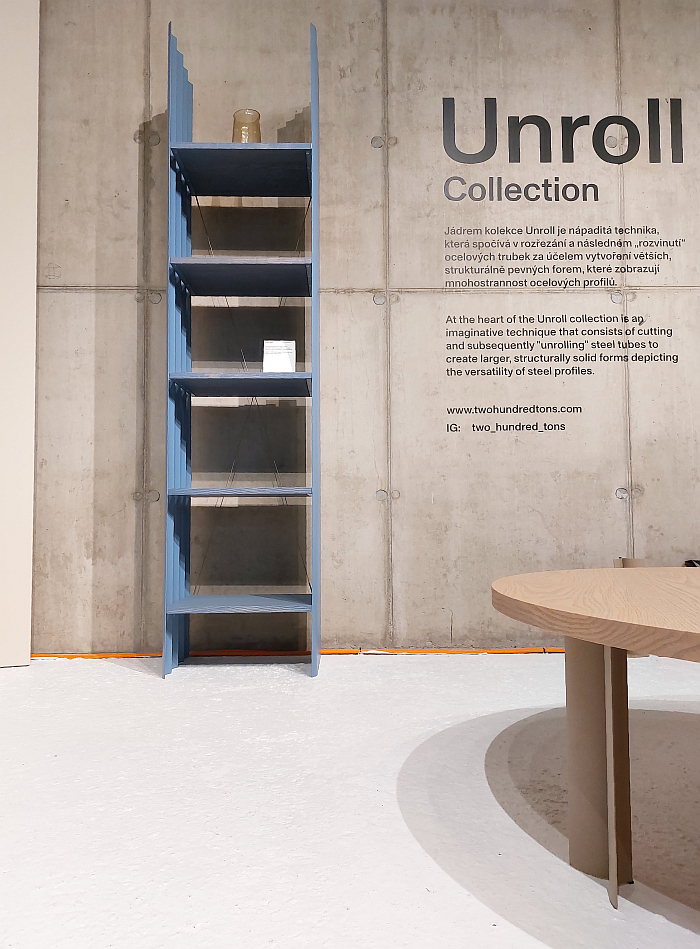
Shelving units that on your first meeting tend to visually suggest they are readymades, as you approach them you're thinking corrugated sheet steel, or the sheets of corrugated Eternit from which Klemens Grund once crafted a sofa; but shelving units whose atmosphere, vibe, is far from suggestive of the readymade. A disparity between visible and invisible that confuses, irritates, and, once you're aware of what you have in front of you, causes you to reflect on what the transformation process has effected beyond the physical changes to the steel tubing; to reflect that while a readymade will always be about the reappropriated object/material, the reappropriated object/material always is, and always will be, at the forefront of your relationship with the object, the Unroll shelves are about the shelves, not the steel tubing, they've gone, they've been unrolled into something new, something unfamiliarly familiar, something that brings genuinely new possibilities, and reminds you of the ubiquity of new possibilities.
Or put another way, you could construct the Unroll collection from corrugated sheet steel or from corrugated Eternit but you would get completely different objects with a completely different agency and which impact differently on the space and the user. The key to the objects being that what they are, the essence of that which they are and which allows them to interact as they do, to have the agency they do, is in the transformation the steel tubes have gone through, is the unrolling. Which brings us back to the importance of production processes, and materials, in the design process.
An unrolling, a transformation through technology and industry, a production process, that means the objects of the Unroll collection are as straightforward, as communicative and as engaging as the objects of the eponymous Two Hundred Tons collection, and that, we'd argue, not least because as products both the Unroll collection and the eponymous Two Hundred Tons collection are the result of working with the material rather than using the material, there is a conversation going on with the steel tube, a discourse, an entering in to a partnership between designer and metal, much as a carpenter discusses the processing of an object with the wood in their hands to ensure an optimal result, so is the steel tube actively involved in its forming, reforming, transformation as an equal partner.
Which is also an important, arguably a fundamental difference, the fundamental difference, to the situation a century or so ago when steel tube was very much a material to be used for furniture, a material to be mastered by human ingenuity for furniture, when no thought was given to partnership. Which, again, may be a metaphor.
It took a while to move on, but we got there, and now we can all enjoy the benefits. And enjoy where the journey takes us all, and takes Two Hundred Tons, from here.
Further details on Two Hundred Tons can be found at https://twohundredtons.com
And for all in or near Prague Two Hundred Tons can be experienced until Sunday September 6th at Bastion Florenc, Křižíkova 2A, Prague 8 as part of Designblok 2024. Full details can be found at www.designblok.cz
